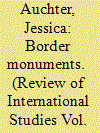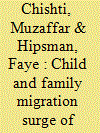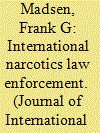|
|
|
Sort Order |
|
|
|
Items / Page
|
|
|
|
|
|
|
| Srl | Item |
| 1 |
ID:
120466


|
|
|
|
|
| Publication |
2013.
|
| Summary/Abstract |
Immigrant deaths have increased in recent years due to changes in border enforcement practices, yet less attention has been paid to the memorialisation of undocumented immigrants who die crossing the US-Mexico border. This article explores the ordering mechanisms of statecraft through an examination of how the dead bodies of undocumented migrants pose a resistance to these mechanisms. I first lay out my conception of statecraft and the bordering practices involved in this specific context, then address the memorialisation of undocumented immigrants who lost their lives crossing the border. The article embarks on a journey through anonymous desert gravesites and small desert cemeteries haunted by the spectres of immigration. It explores the contestation surrounding memorialisation of death through the monument, the narratives of anonymity surrounding the memorialisation of undocumented immigrants, and the counter-memory discourses that emerge in an effort to rewrite the meaning of these migrant deaths. These counter-memorial discourses, I argue, posit desert border monuments as a threat to statecraft because they cannot be situated within the (b)ordering mechanisms of the state.
|
|
|
|
|
|
|
|
|
|
|
|
|
|
|
|
| 2 |
ID:
138412


|
|
|
|
|
| Summary/Abstract |
In the summer months of 2014, a surge in the number of unaccompanied alien children (UAC) and family units from Central America arriving at the U.S.-Mexico border precipitated a crisis for the U.S. government and a firestorm in political and media circles. In recent years, no issue in regional migration (involving the United States, Mexico, and Central America) has attracted this level of red-hot attention and controversy. This article will first examine the numbers—and the trends—of the migration of unaccompanied children prior to and in the wake of this summer’s crisis. It will explore the complex set of push and pull factors responsible for the surge, including security concerns in Central America, structural economic dynamics in the region, the desire for family reunification, U.S. immigration policies that mandate special treatment of child migrants, and the role of smuggling networks. It will survey the policy responses of the governments of the United States, Mexico, El Salvador, Guatemala, and Honduras to the surge—and their impacts. Further, it will examine the ramifications of the child migration influx at the federal, state, and local levels in the United States, as well as the effects of the crisis on the broader political immigration debate in the United States. Lastly, the article will offer recommendations on how to better respond to child migration—both in the short term and on an ongoing, long-term basis.
|
|
|
|
|
|
|
|
|
|
|
|
|
|
|
|
| 3 |
ID:
117962


|
|
|
|
|
| Publication |
2012.
|
| Summary/Abstract |
This year sees the celebration of the first century of international legal provisions against the illicit production and trade of narcotics substances. Accordingly, this is an appropriate moment to evaluate the results obtained. The following essay considers how the international prohibition regime created the crime of drug trafficking. The ensuing function of denied demand is the inescapable basis for the development of organized crime. Second, costs of the regime are critically assessed. The former include institutional costs of law enforcement and of the incarceration of individuals sentenced for drug trafficking and related offences, e.g., violence and financial crimes. The indirect costs are difficult to gauge and impossible to monetize. They include the immense suffering caused by drug trafficking as well as the deterioration of public services due to corruption. The present situation on both sides of the U.S.-Mexico border is sufficiently eloquent evidence. Also, narcotics legislation leads to racial tension since the incarceration rates for non-whites for these offences is considerably higher than for whites in the United State and the United Kingdom. Third, political premises are briefly analyzed, namely the implementation of narcotics liaison offices in foreign jurisdictions and the linking of foreign aid and trade privileges to a certification of trade partners' adherence to U.S. antinarcotic drugs law enforcement. One might claim, somewhat counterintuitively, that decriminalization of drug trafficking is not necessary. Drug trafficking has already been decriminalized de facto, if not de jure, by the sheer, constant saturation of the market place.
|
|
|
|
|
|
|
|
|
|
|
|
|
|
|
|
|
|
|
|
|